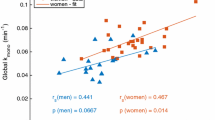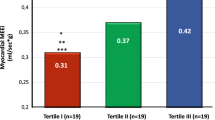Abstract
Purpose
We have previously shown that the myocardium of patients with heart failure (HF) is insulin resistant. Chronic β-adrenergic stimulation has been implicated in insulin resistance in cultured cardiomyocytes in vitro, where sustained noradrenaline stimulation inhibited insulin-modulated glucose uptake. As the failing heart is characterized by increased sympathetic drive, we hypothesized that there is a correlation between pre-synaptic sympathetic function and insulin sensitivity in the myocardium of patients with HF.
Methods
Eight patients (aged 67 ± 7 years) with coronary artery disease and left ventricular dysfunction (ejection fraction 44 ± 10%) underwent function and viability assessment with cardiovascular magnetic resonance. Myocardial glucose utilization (MGU) was measured using positron emission tomography (PET) with 18F-fluorodeoxyglucose (FDG). Pre-synaptic noradrenaline re-uptake was measured by calculating [11C]meta-hydroxy-ephedrine (HED) volume of distribution (V d) with PET. Two groups of healthy volunteers served as controls for the FDG (n = 8, aged 52 ± 4 years, p < 0.01 vs patients) and HED (n = 8, aged 40 ± 6 years, p < 0.01 vs patients) data.
Results
MGU in patients was reduced in both normal remote (0.44 ± 0.14 μmol·min−1·g−1) and dysfunctional (0.49 ± 0.14 μmol·min−1·g−1) segments compared with controls (0.61 ± 0.7 μmol·min−1·g−1; p < 0.001 vs both). HED V d was reduced in dysfunctional segments of patients (38.9 ± 21.2 ml·g−1) compared with normal segments (52.2 ± 19.6 ml·g−1) and compared with controls (62.7 ± 11.3 ml·g−1). In patients, regional MGU was correlated with HED V d.
Conclusion
The results of this study provide novel evidence of a correlation between cardiac sympathetic function and insulin sensitivity, which may represent one of the mechanisms contributing to insulin resistance in failing human hearts.



Similar content being viewed by others
References
Cowie MR, Mosterd A, Wood DA, Deckers JW, Poole-Wilson PA, et al. The epidemiology of heart failure. Eur Heart J 1997;18(2):208–25.
Paternostro G, Camici PG, Lammerstma AA, Marinho N, Baliga RR, Kooner JS, et al. Cardiac and skeletal muscle insulin resistance in patients with coronary heart disease. A study with positron emission tomography. J Clin Invest 1996;98(9):2094–99.
Paternostro G, Pagano D, Gnecchi-Ruscone T, Bonser RS, Camici PG. Insulin resistance in patients with cardiac hypertrophy. Cardiovasc Res 1999;42(1):246–53.
Eisenhofer G, Friberg P, Rundqvist B, Quyyumi AA, Lambert G, Kaye DM, et al. Cardiac sympathetic nerve function in congestive heart failure. Circulation 1996;93(9):1667–76.
Mardon K, Montagne O, Elbaz N, Malek Z, Syrota A, Dubois-Rande JL, et al. Uptake-1 carrier downregulates in parallel with the beta-adrenergic receptor desensitization in rat hearts chronically exposed to high levels of circulating norepinephrine: implications for cardiac neuroimaging in human cardiomyopathies. J Nucl Med 2003;44(9):1459–66.
Bristow MR, Ginsburg R, Minobe W, Cubicciotti RS, Sageman WS, Lurie K, et al. Decreased catecholamine sensitivity and beta-adrenergic-receptor density in failing human hearts. N Engl J Med 1982;307(4):205–11.
Schwaiger M, Kalff V, Rosenspire K, Haka MS, Molina E, Hutchins GD, et al. Noninvasive evaluation of sympathetic nervous system in human heart by positron emission tomography. Circulation 1990;82(2):457–64.
Schafers M, Dutka D, Rhodes CG, Lammertsma AA, Hermansen F, Schober O, et al. Myocardial presynaptic and postsynaptic autonomic dysfunction in hypertrophic cardiomyopathy. Circ Res 1998;82(1):57–62.
Morisco C, Condorelli G, Trimarco V, Bellis A, Marrone C, Sadoshima J, et al. Akt mediates the cross-talk between beta-adrenergic and insulin receptors in neonatal cardiomyocytes. Circ Res 2005;96(2):180–8.
Kim RJ, Fieno DS, Parrish TB, Harris K, Chen EL, Simonetti O, et al. Relationship of MRI delayed contrast enhancement to irreversible injury, infarct age, and contractile function. Circulation 1999;100(19):1992–2002.
Gunning MG, Anagnostopoulos C, Knight CJ, Pepper J, Burman ED, Davies G, et al. Comparison of 201Tl, 99mTc-tetrofosmin, and dobutamine magnetic resonance imaging for identifying hibernating myocardium. Circulation 1998;98(18):1869–74.
Kim RJ, Shah DJ, Judd RM. How we perform delayed enhancement imaging. J Cardiovasc Magn Reson 2003;5(3):505–14.
Spinks TJ, Araujo LI, Rhodes CG, Hutton BF. Physical aspects of cardiac scanning with a block detector positron tomograph. J Comput Assist Tomogr 1991;15(5):893–904.
Kaufmann PA, Gnecchi-Ruscone T, Yap JT, Rimoldi O, Camici PG. Assessment of the reproducibility of baseline and hyperemic myocardial blood flow measurements with 15O-labeled water and PET. J Nucl Med 1999;40(11):1848–56.
Marinho NV, Keogh BE, Costa DC, Lammerstma AA, Ell PJ, Camici PG. Pathophysiology of chronic left ventricular dysfunction. New insights from the measurement of absolute myocardial blood flow and glucose utilization. Circulation 1996;93(4):737–44.
Lorenzoni R, Pagano D, Boyd H, Camici PG. A report system for PET assessment of myocardial viability. Nucl Med Common 1999;20(10):895–9.
Camici P, Marraccini P, Marzilli M, Lorenzoni R, Buzzigoli G, Puntoni R, et al. Coronary hemodynamics and myocardial metabolism during and after pacing stress in normal humans. Am J Physiol 1989;257(3 Pt 1):E309–17.
Asensio C, Jimenez M, Kuhne F, Rohner-Jeanrenaud F, Muzzin P. The lack of beta-adrenoceptors results in enhanced insulin sensitivity in mice exhibiting increased adiposity and glucose intolerance. Diabetes 2005;54(12):3490–5.
Kaneta T, Hakamatsuka T, Takanami K, Yamada T, Takase K, Sato A, et al. Evaluation of the relationship between physiological FDG uptake in the heart and age, blood glucose level, fasting period, and hospitalization. Ann Nucl Med 2006;20(3):203–8.
Leineweber K, Wangemann T, Giessler C, Bruck H, Dhein S, Kostelka M, et al. Age-dependent changes of cardiac neuronal noradrenaline reuptake transporter (uptake1) in the human heart. J Am Coll Cardiol 2002;40(8):1459–65.
Author information
Authors and Affiliations
Corresponding author
Rights and permissions
About this article
Cite this article
Mongillo, M., John, A.S., Leccisotti, L. et al. Myocardial pre-synaptic sympathetic function correlates with glucose uptake in the failing human heart. Eur J Nucl Med Mol Imaging 34, 1172–1177 (2007). https://doi.org/10.1007/s00259-007-0371-z
Received:
Accepted:
Published:
Issue Date:
DOI: https://doi.org/10.1007/s00259-007-0371-z




